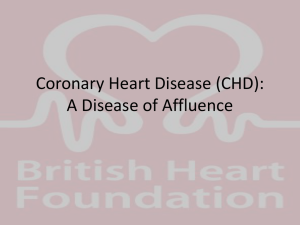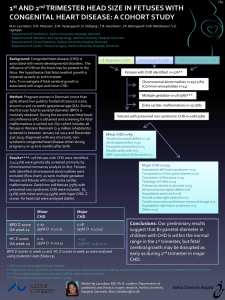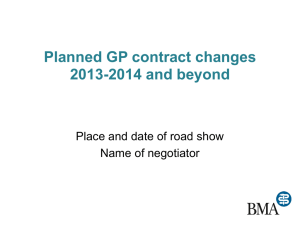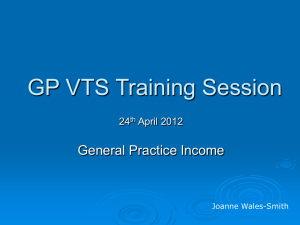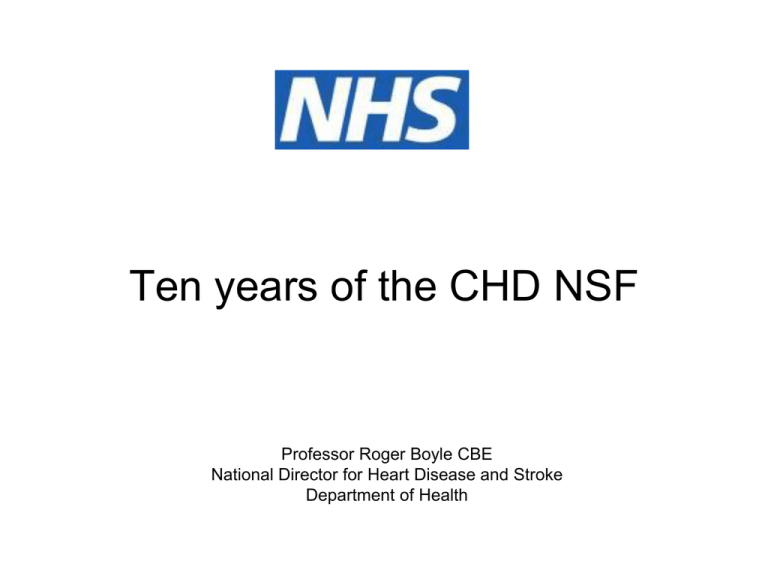
Ten years of the CHD NSF
Professor Roger Boyle CBE
National Director for Heart Disease and Stroke
Department of Health
Frustration
• Poor performance
• Lack of teamwork
• Inability to innovate –
new ideas stifled
• Poor management
– Financial and general
• Poor results
(outcomes)
• Increasing frustration
Modernising care
Improvement programme
Networks
CHD Partnership
CHD Collaborative
Heart Improvement Programme
NHS Improvement
Standards 1 & 2: Reducing heart disease in the population
1. The NHS and partner agencies should develop, implement and monitor policies that reduce the prevalence of
coronary risk factors in the population, and reduce inequalities in risks of developing heart disease.
2. The NHS and partner agencies should contribute to a reduction in the prevalence of smoking in the local population.
SMOKING PREVALENCE
• All adult smoking rates have reduced over the period from 28% in 1998
to 21% in 2008.
• Smoking in the routine & manual groups has reduced from 31% in 2001
to 29% in 2008.
• In 10 years the number of smokers fell by one fifth (2 million fewer
smokers).
England – Smoking Rates & Targets
All Adults & Routine & Manual Groups – 1998 - 2008
Standards 1 & 2: Reducing heart disease in the population
1. The NHS and partner agencies should develop, implement and monitor policies that reduce the prevalence of
coronary risk factors in the population, and reduce inequalities in risks of developing heart disease.
2. The NHS and partner agencies should contribute to a reduction in the prevalence of smoking in the local population.
England – Smoking Rates & Target
Children Aged 11-15 years – 1996 - 2008
SMOKING RATES IN CHILDREN
•
•
Smoking rates in children aged 11-15
years have reduced from 13% to 6% in
the period 1996 to 2006.
These reductions are well ahead of
target.
This is encouraging news for the
future.
IMPACT - SMOKING CESSATION SERVICES
•
•
England – Smoking Cessation Services – 2003/04 - 2008/09
People Setting a Quit Date & Stopped Smoking at 4 Weeks
Record Annual Year/Q (All)
800,000
There has been an increase in the
numbers of people attending Smoking
Cessation services & setting a quit
date from 361,000 in 2003/04 to
671,000 in 2008/09.
Numbers of people successfully
stopping have risen from 205,000 in
2003/04 to 337,000 tin 2008/09.
Smoking Cessation Service Nos. Sewtting Quit Date & Stopping
•
700,000
600,000
Year
2003/04
2004/05
2005/06
2006/07
2007/08
2008/09
% Stopped
57%
56%
55%
53%
52%
50%
500,000
Data
Set Quit Date
Stopped Smoking
400,000
300,000
200,000
100,000
0
2003/04
2004/05
2005/06
2006/07
2007/08
2008/09
Set Quit Date
361,224
529,567
602,820
600,410
680,289
671,259
Stopped Smoking
204,876
298,124
329,681
319,720
350,800
337,054
Financial Yr
Health Survey for England – % Obese, Overweight, Normal &
Underweight – Males and Females – 1993 - 2008
Data Years (All) HSE Table (All) HSE Topic BMI Age All Ages
100
90
80
60
Measure
Underweight d
Normal e
Overweight f
Obese g
50
40
30
20
10
Men
Women
Gender Data
Trend since 2000
Trend since 2000
2008
2007
2006
2005
2004
2003
2002
2001
2000
1999
1998
1997
1996
1995
1994
1993
2008
2007
2006
2005
2004
2003
2002
2001
2000
1999
1998
1997
1996
1995
1994
0
1993
% of the Population
70
Standards 1 & 2: Reducing heart disease in the population
1. The NHS and partner agencies should develop, implement and monitor policies that reduce the prevalence of
coronary risk factors in the population, and reduce inequalities in risks of developing heart disease.
2. The NHS and partner agencies should contribute to a reduction in the prevalence of smoking in the local population.
PHYSICAL ACTIVITY – ALL AGE TREND
Health Survey for England – Physical Activity –
All Ages – 1993, 1998, 2003, 2004, 2006 & 2008
Data Years (All) HSE Table (All) HSE Topic Physical Activity Gender Persons Age All Ages
100%
90%
•
Participation in physical activity which
meets recommended levels has risen
slowly since 2000.
It still remain at around one third of
people who meet the recommended
levels.
70%
% of the Population
•
Trend since 2000
80%
60%
Measure
Low activity
Medium activity
High activity
50%
40%
30%
20%
10%
High activity = Meeting recommended levels
0%
1997
1998
2003
2004
2006
2008
Data Years
Discontinuous
Less Physical Activity accounted for a 4.4% increase in
CHD Mortality 1980-2000 (Capewell et al)
PHYSICAL ACTIVITY – TREND BY AGE
Health Survey for England – Physical Activity –
All Ages – 1993, 1998, 2003, 2004, 2006 & 2008
Data Years (All) HSE Table (All) HSE Topic Physical Activity Gender Women
100.0
There is, however, evidence in the
latest Health Survey for England that
people are over-optimistic about the
duration of self-reported exercise
compared with electronic monitoring.
80.0
70.0
60.0
Measure
Low activity
Medium activity
High activity
50.0
40.0
30.0
20.0
33
30 32
26 28
36 36
35
29 30
26 28
29 28 30
32
10.0
35 34
31 30
34 32
24 25
23
19 18
27 28
20
16 17
13 14
8
9
5
0.0
3
3
4
4
6
1997
1998
2003
2004
2006
2008
1997
1998
2003
2004
2006
2008
1997
1998
2003
2004
2006
2008
1997
1998
2003
2004
2006
2008
1997
1998
2003
2004
2006
2008
1997
1998
2003
2004
2006
2008
1997
1998
2003
2004
2006
2008
•
90.0
The increasing trend is most evident in
the under 35s and those aged 65-74.
% of the Population
•
16-24
25-34
35-44
45-54
55-64
65-74
75 Plus
Age Data
Less Physical Activity accounted for a 4.4% increase in
CHD Mortality 1980-2000 (Capewell et al)
Standards 1 & 2: Reducing heart disease in the population
1. The NHS and partner agencies should develop, implement and monitor policies that reduce the prevalence of
coronary risk factors in the population, and reduce inequalities in risks of developing heart disease.
2. The NHS and partner agencies should contribute to a reduction in the prevalence of smoking in the local population.
Health Survey for England – Blood Pressure – % Population with Hypertension
Controlled, Uncontrolled & Untreated – 2003, 2005, 2006, 2007 & 2008
Data Years (All) HSE Table (All) HSE Topic Blood Pressure Age (All)
25
Steady reduction in the % of
Males with untreated Hypertension
20
20.1
19.0
% of the Population
HYPERTENSION
•
There has been a steady but modest
increase in the % of males & females
who have their hypertension
controlled.
•
There has been a steady reduction in
the % of males who have their
hypertension untreated.
15
10
6.0
16.9
17.1
13.6
12.8
12.3
11.4
Gender
Men
Women
8.4
7.8
7.7
8.0
7.4
8.1
7.2
8.3
6.8
6.3
6.8
7.0
7.0
6.3
6.2
6.3
2006
2007
2008
5.4
0
2003
2005
2006
2007
2008
2003
Hypertensive controlled
2005
Hypertensive uncontrolled
2003
2005
2006
2007
2008
Hypertensive untreated
Measure Data
Population BP fall accounted
for a 9% reduction in
CHD Mortality 1980-2000 (Capewell et al)
England – Hypertension Uncontrolled & Untreated
2003 & 2005-2008 (Health Survey for England)
Data Years (All) HSE Table (All) HSE Topic Blood Pressure Age (All)
30.0
26.3%
23.4%
23.5%
25.0
19.4%
20.0
% of the Population
HYPERTENSION UNTREATED &
UNCONTROLLED
•
People with hypertension untreated &
hypertension treated but uncontrolled
continue to be at risk.
•
Between 2003 & 2008
– the % of men at risk due to
untreated & uncontrolled
hypertension reduced from 26.3%
to 23.4%
– The % of women at risk due to
untreated & uncontrolled
hypertension reduced from 23.5%
to 19.4%.
•
23.4% of men & 19.4% of women
continue to be at risk.
15.8
9.2
7.9
5
18.1
Steady but modest increase
in the % of
Males & Females who
Have their Hypertension
Controlled
Measure
15.0
Hypertensive uncontrolled
Hypertensive uncontrolled
10.0
5.0
Hypertensive untreated
Hypertensive untreated
0.0
2003
2005
2006
Men
2007
2008
2003
2005
2006
Women
2007
2008
Hypertensive untreated
Hypertensive uncontrolled
Standards 1 & 2: Reducing heart disease in the population
1. The NHS and partner agencies should develop, implement and monitor policies that reduce the prevalence of
coronary risk factors in the population, and reduce inequalities in risks of developing heart disease.
2. The NHS and partner agencies should contribute to a reduction in the prevalence of smoking in the local population.
Health Survey for England – Diabetes Prevalence –
All Ages – 1994, 1998, 2003 & 2006
Data Years (All) HSE Table (All) Age All Ages HSE Topic DM Prevalence
6
5.6
4.9
5
4.3
4.2
Diabetes Prevalence (%)
PREVALENCE OF DIABETES
•
Increased diabetes prevalence accounted
for 4.8% of the increase in CHD mortality
from 1980 to 2000.
•
Since then prevalence has increased by
68% for women and 70% for men.
3.9
4
3.4
3.3
2.9
3
2
Measure
2.8
2.5
2.4
1.9
1
Trend since
2000
Trend since
2000
Trend since
2000
0
1994
2003
2006
1994
1998
Women
2003
2006
1994
1998
Men
2003
2006
Persons
Gender Data
Increased Diabetes Prevalence accounted for a 4.8% increase in
CHD Mortality 1980-2000 (Capewell et al)
England – CHD Prevalence
Persons – by Age – 1994,1998, 2003 & 2006 (Health Survey for
Data Years (All) HSE Table (All) HSE Topic IHD Stroke Prevalence
Measure IHD Prevalence (%) Gender Persons
England)
25
Fall
Since
2000
20
Prevalence of IHD (%)
PREVALENCE OF CHD
•
All age prevalence reduced from 5.7% in
1998 to 5.2% in 2006.
•
There have been similar reductions in the
age groups 45-54 & 65-74.
•
with a more pronounced reduction in the
55-64 age group – from 9.6% in 1998 to
7% in 2006.
•
Prevalence in the 75 plus age group has
risen from 20.3% in 1998 to 22.8% in
2006.
•
This is likely to be the result of delayed
onset & increasing average age in the 75
plus age group.
1998
15
Fall
Since
2000
10
20.3
21.4
22.8
Fall
Since
2000
18.2
15.1 16.1 15.3 15.1
Fall
Since
2000
5
8.1
9.6
8.4
7.0
5.0
2.6
3.0
2.7
5.7
5.2
5.2
2.4
0
1994 1998 2003 2006 1994 1998 2003 2006 1994 1998 2003 2006 1994 1998 2003 2006 1994 1998 2003 2006
45-54
55-64
65-74
Age Data
75 Plus
All Ages
Coronary Heart Disease – QOF Prevalence Aged 16+ 2006/7 & 2007/8 & % of
Org Level SHA
Estimated CHD Diagnosed (16+ 2006) – England by SHA
100.0%
North East
QOF 16+
prevalence
Is 87% of
expected
(estimated)
Prevalence
London
QOF 16+ prevalence
Is 61.5% of expected
(estimated) prevalence
90.0%
80.0%
70.0%
% of CHD Diagnosed
Ranked QOF 2007/8 Prevalence
as a % of Estimated Prevalence
60.0%
50.0%
Data
Change % 16+
% Diagnosed 16+
40.0%
CHD Change in Prev Aged 16+ (%)
Growth or reduction in 2007/8 Prevalence
Compared with 2006/7 Prevalence
30.0%
20.0%
There was little or no
change in QOF
prevalence between
2006/7 & 2007/8
10.0%
0.0%
-10.0%
North
East
Yorkshir
e&
Humber
North
West
East
South East Of
Midland
Central England
s
Change % 16+
0.0%
-0.5%
-1.0%
-0.5%
0.1%
% Diagnosed 16+
87.2%
86.5%
83.8%
82.5%
78.2%
South
East
Coast
South
West
West
Midland London
s
-0.2%
-1.1%
-1.1%
-1.0%
-0.8%
77.2%
76.7%
74.6%
70.5%
61.5%
(1)
Modelled estimates of prevalence of CHD for PCTs in England Version 1.0 (Eastern Region Public Health Observatory, September 2008) These estimates of the
SHA
prevalence of CHD in people aged 16+ have been calculated using a model developed at the Dept of Primary Care and Social Medicine, Imperial College, London. The model
was developed using data from the 2003-2004 Health Surveys for England. The model takes into account age, sex, ethnicity, smoking status and deprivation score.
Vascular Programme – CHD - QOF Prevalence aged 16 years plus as a % of Estimated
Prevalence- Average for PCTs by IMD Quintile – 2006/7 – 2008/9 – England
Average QOF Prevalence as % of Estimated Prevalence - 16 yrs plus
SHA (All) SHA Code (All) Org Level PCT Old SHA (All) PCT (All) Spearhead (All) PCT Short (All)
100%
Average of CHD Prev QOF as % of Est
90%
80%
79%
79%
81%
78%
80%
79%
79%
76%
75%
79%
77%
74%
70%
66%
66%
65%
2006/7
2007/8
2008/9
60%
50%
40%
30%
20%
10%
0%
2006/7
2007/8
2008/9
1
Quintile 1
Least
Deprived
2006/7
2007/8
2
2008/9
2006/7
2007/8
2008/9
3
Quintile Ave IMD Year
2006/7
2007/8
4
2008/9
5
Quintile 5
Most
Deprived
Standards 3 & 4: Preventing CHD in high risk patients
3. General practitioners and primary care teams should identify all people with established cardiovascular disease and
offer them comprehensive advice and appropriate treatment to reduce their risks.
4. General practitioners and primary health care teams should identify all people at significant risk of cardiovascular
disease but who have not developed symptoms and offer them appropriate advice and treatment to reduce their risks.
100%
QOF Reported
BP<150/90
90%
80%
QOF Reported
BP<150/90
as % of
CHD Register
70%
% of People with CHD
60%
Data
QR BP <150/90
QOF BP<150/90
REG BP<150/90
50%
40%
QResearch BP<150/90
Pre-introduction of QOF
30%
20%
10%
0%
Q1
Q2
Q3
Q4
Q1
Q2
Q3
Q4
Q1
Q2
Q3
Q4
Q1
Q2
Q3
Q4
Q1
Q2
Q3
Q4
Q1
Q2
Q3
Q4
Q1
Q2
Q3
Q4
Q1
Q2
Q3
Q4
BLOOD PRESSURE – PEOPLE WITH CHD
•
QOF reporting started in 2004/05.
•
QResearch has published earlier trends in
BP control for their population of 3.4 million
people.
•
The trend for the QResearch sample
(01/02-06/7) & the QOF results (04/0508/09) shows a steady increase in the % of
people on CHD registers with BP<150/90.
•
By 2008/09 QOF reported 89.7% of people
with CHD had BP<150/90.
England – QOF % of People with CHD with BP <150/90 – 2001/02 – 2008/09
QResearch Population & National QOF Results
2001/02
2002/03
2003/04
2004/05
2005/06
2006/07
2007/08
2008/09
Year Quarter
100%
QOF Reported
Chol <5mmol/l
90%
80%
70%
QOF Reported
Chol <5 mmol/l
as % of
CHD Register
60%
50%
40%
30%
QResearch Chol <5mmol/l
Pre-introduction of QOF
20%
10%
0%
Q1
Q2
Q3
Q4
Q1
Q2
Q3
Q4
Q1
Q2
Q3
Q4
Q1
Q2
Q3
Q4
Q1
Q2
Q3
Q4
Q1
Q2
Q3
Q4
Q1
Q2
Q3
Q4
Q1
Q2
Q3
Q4
% of People with CHD
CHOLESTEROL – PEOPLE WITH CHD
•
The trend for the QResearch sample
(01/02-06/7) & the QOF results (04/0508/09) shows a steady increase in the % of
people on CHD registers with Cholesterol
of 5 mmol/l or less.
•
By 2008/09 QOF reported 82.1% of people
with CHD had cholesterol of 5 mmol/l or
less.
England – QOF % of People with CHD with Cholesterol 5mmol/l or less –
2001/02 – 2008/09 - QResearch Population & National QOF Results
2001/02
2002/03
2003/04
2004/05
2005/06
2006/07
2007/08
2008/09
Data
QR Chol <5 mmol/l
QOF Chol <5 mmol/l
Reg Chol <5 mmol/l
England
QOF
% of
People
with
with BP
<150/90
– 2004/05 – 2008/09
Org Level PCT–PCT
Code (All)
Practice
Code (All)
SHACHD
(All) Spearhead
(All) SHA
Name (All)
Results for PCTs by IMD Quintile
100%
Quintile 1
Least
Deprived
Quintile 5
Most
Deprived
90%
PCT Short
85%
80%
1
2
3
IMD Quintile Year
4
5
2008/9
2007/8
2006/7
2005/6
2004/5
2008/9
2007/8
2006/7
2005/6
2004/5
2008/9
2007/8
2006/7
2005/6
2004/5
2008/9
2007/8
2006/7
2005/6
IMD QUINTILE 5
QOF % 2004/5 2008/9
Max
87%
92%
Ave
82%
89%
Min
78%
87%
2004/5
2008/9
2007/8
2006/7
70%
IMD QUINTILE 1
QOF % 2004/5 2008/9
Max
87%
91%
Ave
85%
90%
Min
81%
88%
2005/6
75%
2004/5
% of People with CHD
95%
CHD06 QOF %
England
–Code
QOF
of People
with CHD
with
Org Level
PCT PCT
(All) %
Practice
Code (All) Spearhead
(All) SHA
(All)Cholesterol
5mmol/l or less –
2004/05 – 2008/09 – BY PCT & IMD Quintile
100%
95%
90%
CHD08 QOF %
Quintile 1
Least
Deprived
Quintile 5
Most
Deprived
85%
80%
PCT Short
75%
70%
65%
2
3
IMD Quintile Year
4
5
2008/9
2007/8
2006/7
2004/5
2008/9
2007/8
2006/7
2005/6
2004/5
2008/9
2007/8
2006/7
2005/6
2004/5
2008/9
2007/8
2006/7
2005/6
2004/5
2008/9
2007/8
2005/6
2004/5
2006/7
1
2005/6
IMD QUINTILE 5
QOF % 2004/5 2008/9
Max
80%
86%
Ave
69%
81%
Min
54%
77%
IMD QUINTILE 1
QOF % 2004/5 2008/9
79%
85%
55% Max
Ave
73%
82%
Min
67%
77%
50%
60%
England – Statin Prescribing – Total Statins (Proprietary & Generic)
Statin Type (All) Prescribed Items (000s) & Net Ingredient Costs (£000s)
800,000
60,000
NSF
CHD
700,000
50,000
500,000
400,000
40,000
30,000
300,000
20,000
200,000
Statins – Net Ingredient
Cost (£000s)
Statins – Prescribed
Items (000s)
10,000
100,000
Year
08/09
07/08
06/07
05/06
04/05
03/04
02/03
01/02
00/01
99/00
98/99
97/98
96/97
95/96
94/95
93/94
0
92/93
0
Prescribed Items (000s)
Total Statins
Between 2000/01 & 2008/09
-Net Ingredient Cost - up 38%
-Prescribed Items - up 388%
91/92
Net Ingredient Cost (000s)
600,000
Data
England – Statin Prescribing – Proprietary & Generic Statins – 2000/01 – 2008/09
% Share of Prescribed Items (000s) & Net Ingredient Costs (£000s)
100%
Sum of % of Total
100% 100% 100%
90%
% of Total Statins - NIC & Prescribed Items
100% 100% 100%
Generic Statins
72% of Items
In 2008/09
80%
86%
85%
81%
72%
82%
69%
70%
62%
60%
54%
60%
62%
62%
Statin Type
49%
Generic
Proprietory
50%
40%
51%
38%
46%
40%
38%
Generic Statins
14% of NIC
In 2008/09
38%
30%
31%
28%
19%
20%
15%
18%
14%
10%
0%
0%
0%
0%
0%
0%
0%
00/01 01/02 02/03 03/04 04/05 05/06 06/07 07/08 08/09 00/01 01/02 02/03 03/04 04/05 05/06 06/07 07/08 08/09
Items(000s)
Prescribed
Items
NIC(£000s)
Net Ingredient
Cost
Data2 Year
Standards 5,6 & 7: Heart attack and other acute coronary syndromes
5. People with symptoms of a possible heart attack should receive help from an individual equipped
with and appropriately trained in the use of a defibrillator within 8 minutes of calling for help, to
maximise the benefits of resuscitation should it be necessary.
PHASE 1 - SAVING LIVES – OUR
HEALTHIER NATION
• The White Paper ‘Saving Lives:
Our Healthier Nation’ was
launched in 1999
• £2m invested in installing 681
automated external defibrillators
(AEDs) in busy public places
(airports, stations, shopping
centres)
• From February 2005 all 681
AEDs were handed over to 21
Ambulance Services & financial
allocations made to each Trust
to ensure programme continuity.
• All AEDs managed as core NHS
activity.
PHASE 2 - THE NHS PLAN
• The NHS Plan (July 2000) 3,000
automated external defibrillators
(AEDs) in public places.
• £6m was awarded to the BHF
• Community Defibrillation Officers
appointed
• A further 2,300 AEDs were funded –
based on bids received from
Ambulance Trusts
Over 100 survivors to hospital discharge
Over 100 survivors to hospital discharge
Standards 5,6 & 7: Heart attack and other acute coronary syndromes
6. People thought to be suffering from a heart attack should be assessed professionally
and, if indicated, receive aspirin. Thrombolysis should be given within 60 minutes of
calling for professional help.
Acute Myocardial Infarction - STEMI -Thrombolysis
% Door to Needle in 30 minutes & % Call to Needle in 60 minutes – 2002 - 2009
CY Quarter (All) New SHA (All) Level England SHA Short (All)
% Door to Needle
in 30 minutes
100%
90%
80%
70%
60%
Data
% Call to Needle
in 60 minutes
50%
DTN30 %
CTN60 %
40%
30%
20%
10%
2009/10 Q2
2009/10 Q1
2008/09 Q4
2008/09 Q3
2008/09 Q2
2008/09 Q1
2007/08 Q4
2007/08 Q3
2007/08 Q2
2007/08 Q1
2006/07 Q4
2006/07 Q3
2006/07 Q2
2006/07 Q1
2005/06 Q4
2005/06 Q3
2005/06 Q2
2005/06 Q1
2004/05 Q4
2004/05 Q3
2004/05 Q2
2004/05 Q1
2003/04 Q4
2003/04 Q3
2003/04 Q2
2003/04 Q1
2002/03 Q4
2002/03 Q3
2002/03 Q2
2002/03 Q1
0%
2001/02 Q4
THROMBOLYSIS FOR STEMI
•
Thrombolysis for STEMI was implemented
soon after the publication of the NSF.
•
The % of patients with Call to Needle within
60 minutes reached 70% in Q4 2007/08.
•
The % of patients with Door to Needle within
30 minutes reached 80% plus from Q2
2003/04.
•
In many parts of the country pre-hospital
thrombolysis was implemented & by 2007
17% of thrombolysis was being given before
arrival at the hospital.
Fin Yr Q
THROMBOLYSIS & PRIMARY PCI
•
From 2003 Primary PCI started to be
adopted as a more effective alternative.
•
The National Infarct Angioplasty Project
(NIAP) evaluated implementation at pilot
sites.
•
DH guidance (2008) recommended the rollout of PPCI to areas where 120 call to
balloon times could be delivered.
•
Thrombolysis now accounts for 40% of post
STEMI treatment & PPCI accounts for 60%.
Acute Myocardial Infarction - STEMI -Thrombolysis
Shift from Thrombolysis to Primary PCI
100
90
100%
80
% Thrombolysis
70
60%
60
50
40
40%
30
20
10
% Primary PCI
0%
0
2003
2004
2005
2006
2007
2008
2009
lytic
therapy
pPCI
How are heart attacks being
managed?
100
90
80
70
60
Primary angioplasty
50
40
30
20
10
0
20
03
-4
20
04
-5
20
05
-6
20
06
-7
20
07
-8
20
08
-9
20
09
-1
0
%
Pre-hospital
thrombolytic treatment
In-hospital
thrombolytic treatment
Standards 5,6 & 7: Heart attack and other acute coronary syndromes
7. NHS Trusts should put in place agreed protocols/systems of care so that people admitted to hospital
with proven heart attack are appropriately assessed and offered treatments of proven clinical and cost
effectiveness to reduce their risk of disability and death.
Acute Myocardial Infarction - STEMI – Primary PCI
CTB 2008 & DTB 2008 & 2009 (National Mean of Unit Median Times)
140
Sum of Minutes
116.6
120
100
Minutes
PRIMARY PCI – RESPONSE TIMES
Door to Balloon (DTB)
•
The national mean time reduced from 61.7
minutes in 2007 to 53.8 minutes in 2008
•
In 2008 – 81.3% were less than 90 minutes
Call to Balloon
•
The national mean time Call to Balloon was
116.6 minutes in 2008
•
In 2008 - 78.8% were less than 150 minutes.
DTB - 81.3%
< 90 mins
80
CTB – 78.8%
< 150 mins
61.7
60
53.8
40
20
0
2007
OUTCOMES FOR PATIENTS WITH ACS
•
While 30 day mortality after nSTEMI has
been falling, outcomes for patients with ACS
(nSTEMI) remain of concern.
•
The immediate diagnosis & treatment of
nSTEMI has lagged behind that for STEMI.
2008
Door to Balloon
Source: BCIS Audit – P.Ludman
Measure Year
Unadjusted 30-day mortality after nSTEMI is falling
Some 1200-1500 fewer
deaths each year
NICE GUIDANCE – MARCH 2010
•
NICE is preparing clinical guidance on
–
•
The management of ACS - published March
2010
Future improvements in management &
treatment to be based on guidance issued.
2008
Call to Balloon
Unpublished data - John Birkhead
Falling mortality rates – MINAP data
STEMIs
30 days
Falling mortality rates – MINAP data
Non STEMIs
30 days
Standard 8: Stable angina
8. People with symptoms of angina or suspected angina should
receive appropriate investigation and treatment to relieve their pain and reduce their risk
of coronary events.
England – Rapid Access Chest Pain Clinics – 2002/03 – 2009/10
National Trend in the Number of Referrals
Area Name (All) SHA (All) Area (All) SHA Name (All) Level SHA Area Code (All)
35,000
Sum of Patients
30,000
Trend
25,000
RACPC Referrals
RAPID ACCESS CHEST PAIN CLINICS
•
Central funding enabled Rapid Access Chest
Pain Clinics to be developed across the
country
•
Since 2002/03 referrals have been running at
over 25,000 in each quarter
•
Over the period since their introduction there
has been an upward trend in referrals
nationally – so no let up in symptomatic
presentation.
•
In each of the last 5 quarters to June 2009
there have been over 30,000 referrals.
20,000
Total
Linear (Total)
15,000
10,000
5,000
0
Q4
20
03-
Q1
Q2
Q3
2004-05
Q4
Q1
Q2
Q3
2005-06
Q4
Q1
Q2
Q3
Q4
Q1
Q2
2006-07
Q3
Q4
Q1
2007-08
Q2
Q3
Q4
2008-09
Q1
20
09-
Year Quarter
100%
97% of referrals
Seen within 14 days
90%
90% of referrals
made within 24 hrs
80%
% of RACP Clinical Referrals
SPEED OF ACCESS & % CARDIAC IN ORIGIN
•
Since 2006 90% of referrals have been made
within 24 hrs of GP decision to refer.
•
Over 95% of referrals have been seen within
14 days (97% in the quarter to June 2009)
•
Over the first year of their introduction
specificity of referral increased & over 40% of
referrals have been cardiac in origin (43% in
the quarter to June 2009)
England – Rapid Access Chest Pain Clinics – 2002/03 – 2009/10
% Referred
within 24 hours, Seen with 14 days & % Cardiac in Origin
Level National Area
(All) SHA Name (All)
70%
60%
Data
% Refs within 24 hrs
% All Refs Seen in 14 days
% Outcome Cardiac
50%
40%
43% of referrals
Cardiac in origin
30%
Rapid increase in
Specificity of referral
20%
10%
0%
Q4 Q1 Q2 Q3 Q4 Q1 Q2 Q3 Q4 Q1 Q2 Q3 Q4 Q1 Q2 Q3 Q4 Q1 Q2 Q3 Q4 Q1
20
03-
2004-05
2005-06
2006-07
Year Quarter
2007-08
2008-09
20
09-
Standards 9 & 10: Revascularisation
9. People with angina that is increasing in frequency or severity should
be referred to a cardiologist urgently or, for those at greatest risk, as an emergency.
10. NHS Trusts should put in place hospital-wide systems of care so that patients with suspected or
confirmed coronary heart disease receive timely and appropriate investigation and treatment to relieve
their symptoms and reduce their risk of subsequent coronary events.
England – Angiography Activity –
Angiography Alone & Angiography with PCI - 2000-2001 to 2007-2008
HA/Board England
ANGIOGRAPHY – GROWTH IN ACCESS
200,000
180,000
160,000
•
Access to angiography has
improved substantially
The number of angiograms
increased by 66% between
2000/01 & 2007/08.
140,000
120,000
Angiograms
•
Increase of 66%
2000/1-2007/8
Intervention
Angiography
Angio Plus PCI
100,000
80,000
60,000
40,000
20,000
0
ANGIOGRAPHY – SPEED OF ACCESS
2000-2001 2001-2002 2002-2003 2003-2004 2004-2005 2005-2006 2006-2007 2007-2008
Angiography
98,949
106,329
114,658
126,434
130,339
139,377
147,757
166,125
Angio Plus PCI
8,272
8,738
10,621
13,956
14,791
15,553
14,170
11,461
Data
England – Total Waiters by Time Band – Angiography
April 2004 – December 2009
Year (All) Quarter (All) First Last (All) Intervention Angiography Old SHA (All) New SHA (All) Trust Short (All)
•
•
25,000
20,000
Data
Total Waiters
Down 66%
15,000
10,000
5,000
Waiting 0-1
Months = 26%
Waiting 0-1
Months = 82%
0
Apr-04
MayJun-04
Jul-04
Aug-04
Sep-04
Oct-04
Nov-04
Dec-04
Jan-05
Feb-05
Mar-05
Apr-05
MayJun-05
Jul-05
Aug-05
Sep-05
Oct-05
Nov-05
Dec-05
Jan-06
Feb-06
Mar-06
Apr-06
MayJun-06
Jul-06
Aug-06
Sep-06
Oct-06
Nov-06
Dec-06
Jan-07
Feb-07
Mar-07
Apr-07
MayJun-07
Jul-07
Aug-07
Sep-07
Oct-07
Nov-07
Dec-07
Jan-08
Feb-08
Mar-08
Apr-08
MayJun-08
Jul-08
Aug-08
Sep-08
Oct-08
Nov-08
Dec-08
Jan-09
Feb-09
Mar-09
Apr-09
MayJun-09
Jul-09
Aug-09
Sep-09
Oct-09
Nov-09
Dec-09
•
•
Speed of response has improved
markedly.
Since April 2004
Total waiters have reduced by over
15,000 - down 66%
In April 2004 - 26% of people
waited a month or less
By December 2009 – 82% of
people waited a month or less.
Numbers Waiting
•
Period
9+ mths
8-9 mths
7-8 mths
6-7 mths
5-6 mths
4-5 mths
3-4 mths
2-3 mths
1-2 mths
0-1 mths
Standard 11: Heart failure
11. Doctors should arrange for people with suspected heart failure to be offered appropriate
investigations (e.g electrocardiography, echocardiography) that will confirm or refute the diagnosis. For
those in whom heart failure is confirmed, its cause should be identified – treatments most likely to both
relieve their symptoms and reduce their risk of death should be offered.
ECHOCARDIOGRAPHY – SPEED OF
ACCESS
England – Waiting Time in Weeks –
April 2008 & March 2009 - Echocardiography
Diagnostic Echocardiography SHA Name (All)
9,000
8,000
In March 2009
88% waited less than 4 weeks
99% waited lss than 6 weeks
•
•
Diagnostic waiting times have
reduced as part of achieving 18
weeks
For echocardiography – in March
2009
– 88% of people waited less than
4 weeks
– 99% of people waited less than
6 weeks.
Waiting List Numbers
7,000
6,000
5,000
Month
Apr-08
Mar-09
4,000
3,000
2,000
1,000
0
0 <01
weeks
01 <02 02 <03 03 <04 04 <05 05 <06 06 <07 07 <08 08 <09 09 <10 10 <11 11 <12 12 <13
weeks weeks weeks weeks weeks weeks weeks weeks weeks weeks weeks weeks
13+
weeks
Apr-08
7630
7321
5327
3448
1756
668
327
149
130
101
90
58
22
45
Mar-09
7901
7562
5697
3605
2360
915
91
57
16
12
6
3
1
13
Data
Standard 11: Heart failure
11. Doctors should arrange for people with suspected heart failure to be offered appropriate
investigations (e.g electrocardiography, echocardiography) that will confirm or refute the diagnosis. For
those in whom heart failure is confirmed, its cause should be identified – treatments most likely to both
relieve their symptoms and reduce their risk of death should be offered.
HEART FAILURE - MORTALITY
•
There is some evidence that mortality among newly diagnosed cases of heart failure has decreased
(South East England Hillingdon/Bromley 1995/97 & Hillingdon/ Hastings 2004/05).
Heart Failure – Improval in survival of incident cases of Heart Failure
Cohort Study – 1995/97 & 2004/05 (Mehta et al, Heart 2009 95:1851-1856)
England – Heart Failure –
Hospital Finished Consultant Episodes & Admissions –
By Specific Diagnosis - 1998/9-2008/9
Groups Heart Failure
80,000
60,000
50,000
Data
FCEs
Admissions
40,000
30,000
20,000
10,000
Congestive heart failure
Left ventricular failure
Heart failure, unspecified
Year
Left Ventricular Failure - Diagnosis
Admissions
& FCEs have reduced
FCEs by 35% since 1998/99 & by 30% since 2000/01
Admissions by 49% since 1998/99 & by 43% since 2000/01
2008/9
2007/8
2006/7
2005/6
2004/5
2003/4
2002/3
2001/2
2000/1
1999/0
1998/9
2008/9
2007/8
2006/7
2005/6
2004/5
2003/4
2002/3
2001/2
2000/1
1999/0
1998/9
2008/9
2007/8
2006/7
2005/6
2004/5
2003/4
2002/3
2001/2
2000/1
1999/0
0
1998/9
Heart Failure - Admissions & FCEs
70,000
Receipt of cardiac rehabilitation
80
70
60
50
2005/6
2006/7
2007/8
2008/9
% 40
30
20
10
0
Acute MI
CABG
PCI
All cases
% of patients with MI, CABG and
PCI receiving cardiac rehabilitation
70
60
50
2005/6
2006/7
2007/8
2008/9
40
%
30
20
10
0
NE
NW
SEC E of E Y & H
WM
SW
EM
SC
Lond
England
MI
CABG
PCI
Wales
MI
CABG
PCI
Reasons for rejection
Uptake by ethnicity
Quality requirement two: Diagnosis and Treatment
People presenting with arrhythmias, in both emergency and elective settings,
receive timely assessment by an appropriate clinician to ensure accurate diagnosis
and effective treatment and rehabilitation.
.
Heart Rhythm Devices – UK
National Surveys
•
Annual surveys & reports
•
Tracking progress –
nationally & by Network &
PCT
•
Compare observed with
expected
•
2009 Report due July
2010
•
Overall mapping shows
improved access rates
between 2006 & 2008 for
– Pacemakers
– ICD
– CRT
Source: Cunningham et al, Heart Rhythm Devices
UK National Survey, 2008
Outcomes – CHD Mortality
CHD MORTALITY UNDER 75
•
Between 1995/97 & 2005/07 average
annual deaths from all causes
reduced from 202,061 to 159,921
England – All Cause Mortality – Aged Under 75 years –
Number of Deaths by Cause – 3 Year Average 1995-97 & 2005-07
Level National Measure OBS
250,000
202,061
200,000
•
Deaths from CHD reduced from
46,615 to 24,495
Deaths from Other Circulatory
Diseases reduced from 27,610 to
18,557.
159,921
56,472
NUmber of deaths
•
Data
150,000
54,862
71,363
100,000
Other Causes
Cancer
Other Circulatory
CHD
62,007
27,610
50,000
18,557
46,615
24,495
0
P Ave 95-97
1995-97
P Ave 05-07
ENGLAND
2005-07
SHA Year
England – All Cause Mortality – Aged Under 75 years –
Directly Standardised Rate (per 100,000) by Cause – 1995-97 & 2005-07
•
•
Between 1995/97 & 2005/07 mortality rates from All Causes
reduced from 397 per 100,000 to 302
per 100,000 – down 24%
Mortality rates from CHD reduced
from 89 to 45 per 100,000 – down
50%
Mortality rates from Other Circulatory
Disease reduced from 52 to 34 per
100,000 – down 35%
Level National Measure DSR
450
397
400
Mortality - DSR per 100,000 - All Causes
•
350
302
115
300
Data
250
200
107
141
150
115
52
100
50
34
89
45
0
P Ave 95-97
1995-97
P Ave 05-07
2005-07
ENGLAND
Other Causes
Cancer
Other Circulatory
CHD
Outcomes – CVD Mortality
CVD MORTALITY UNDER 75
•
As a result of these reductions there
has been a reduction of 47% in death
rates from circulatory disease.
•
The Public Service Agreement target
was to achieve a 40% reduction by
2010.
•
The target has been achieved 5
years ahead of schedule.
INEQUALITIES
•
In addition, the aim is to reduce the
absolute gap between the worst fifth
of areas in the country for health &
deprivation (the spearhead PCTs) &
the national average by 40% by
2010.
•
The absolute gap has reduced by
38.4% between 1996 and 2007 –
well on the way to achieving that
target.
Outcomes – CHD Mortality
160
Ave CHD DSR
Range of
DSRs for
LAs in the
5th Quintile
In 95/97
140
120
DSR per 100,000
CHD MORTALITY UNDER 75
•
However, comparison of the
changing rates between Local
Authorities – grouped into deprivation
quintiles (using the Index of Multiple
Deprivation) shows a different
picture.
•
In 1995-97, there was a large overlap
in the mortality rates between the
local authorities in the 1st (least
deprived) and 5th (most deprived)
quintiles.
•
By 2005-07, the gap had widened &
the overlap had almost disappeared.
England – CHD Mortality – Aged Under 75 yrs – Directly Standardised
Rates (DSR) – Local Authorities 1st & 5th IMD Quintiles – 1995-97 & 2005-07
Level LA Measure DSR SHA (All)
CHD
Under 75s
100
Overlap
80
Area Short
The gap
has widened
60
40
20
0
5
1
5
1
DSR 05-07
DSR 95-97
1995-97
2005-07
Year IMD Quintile
•
•
However, the variation in mortality
rates within the 1st & 5th deprivation
quintiles has narrowed
AND
In both the 1st & 5th quintiles the
highest (worst) mortality rates in
2005-07 are lower (better) than the
lowest (best) mortality rates in 199597.
160
Ave CHD DSR
CHD
Under 75s
140
BUT
120
DSR per 100,000
•
England – CHD Mortality – Aged Under 75 yrs – Directly Standardised
Rates (DSR) – Local Authorities 1st & 5th IMD Quintiles – 1995-97 & 2005-07
Level LA Measure DSR SHA (All)
100
The variation has narrowed
80
60
Area Short
The variation has narrowed
40
AND
In both cases the
worst in 05/07 is better
than the best in 95/97
20
0
5
1
5
1
DSR 05-07
DSR 95-97
1995-97
2005-07
Year IMD Quintile
Next ten years!
DSR deaths per 100,000
400
350
?
115
300
250
200
107
141
99
150
100
50
115
52
89
89
34
45
16
23
2005-7
2015-17
0
1995-97
Other causes
Cancer
Other CVD
CHD
How it looked 10 years ago
1995-97
22%
29%
13%
36%
CHD
Other CVD
Cancer
Other
How it looks now
2005-7
15%
36%
11%
38%
CHD
Other CVD
Cancer
Other
How it might look 10 years from now
- the next 50%
2015-17
10%
7%
CHD
Other CVD
Cancer
Other
44%
39%
34,000 fewer deaths each year cf. 1995-97
Challenges for hospital care
• Maintaining quality during current
economic climate
• Driving up efficiency
– Reducing LOS
– Reducing admissions/readmissions
– Reducing follow-ups
• Working primary care to improve CV care
and referral patterns
What is left for primary care to do?
• Further optimise secondary prevention
• Get upstream – Health Checks
– Prevent CVD and diabetes
• Identify and manage people with AF
– Prevent about 5,000 strokes
• Identify people with FH
– Entirely treatable condition once diagnosed
• Run the NHS!



